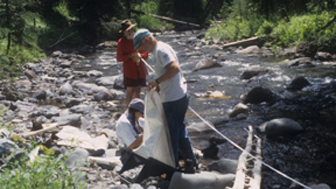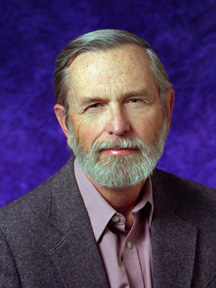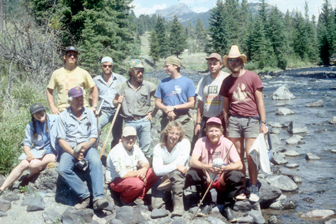Return to Yellowstone: ISU scientists studying fires’ legacy
August 5, 2008
A 10-member team of scientists with links to Idaho State University is heading into Yellowstone National Park for about a two-week period this August to test their theories of the effects of wildfire on natural ecosystems and stream ecology.
This summer is the 20th anniversary of the 1988 Yellowstone fires that burned about 1.2 million acres total, including about 793,000 acres within the park, nearly 36 percent of the park’s total acreage.
 The team will be led by well respected stream ecologist Wayne Minshall, Ph.D., a professor emeritus of biological sciences at ISU, and his colleague Colden Baxter, ISU assistant professor of biological sciences.
The team will be led by well respected stream ecologist Wayne Minshall, Ph.D., a professor emeritus of biological sciences at ISU, and his colleague Colden Baxter, ISU assistant professor of biological sciences.
They’ll be in the park from Aug. 11 to around Aug. 22. They will spend seven days in the backcountry checking sites in the Cache Creek area, and then will be examining sites nearer to the road at several areas in the park.
Cache Creek is located in the northeast corner of the park and is a tributary of the Lamar River. It was extensively burned in 1988.
“It is really like reading a book – you can’t wait to get to the last chapter,” said Minshall in a recent interview. “You want to see how it ends, but we’re not there, yet.”
The researchers began studying the effects of the fires in 1988 “when the fires were still smoking,” noted Minshall. For the first five years following the 1988 fires Minshall and other ISU faculty and graduate students annually studied a number of sites in the park.
 Over the next five years they continued to study their Cache Creek sites annually, and visited other sites irregularly, before studying the bulk of the sites again in 1998, the 10th anniversary after the fires.
Over the next five years they continued to study their Cache Creek sites annually, and visited other sites irregularly, before studying the bulk of the sites again in 1998, the 10th anniversary after the fires.
However, since 1998, they have not visited the majority of their sites. Of the few they have studied since 1998, none have been visited in the last six or seven years.
“This will give us the opportunity to reflect on the last 20 years, to confirm changes we predicted and discover unexpected things,” Minshall said. “We’ll be studying the interplay between climate and weather conditions and the fire legacy.”
Joining Minshall, Baxter and current ISU graduate students, will be former ISU graduate students and colleagues who participated in the initial studies.
“It will be a reunion of sorts, with scientists coming from all over the country to help complete this study,” Minshall said.
Minshall’s research focus as an ecologist and biologist is the status of the aquatic organisms in the streams, checking which species are present and their relative abundance.
He focuses on bottom-dwelling invertebrates, including various insect species that spend a portion of their lifecycle in the stream. Of particular importance to him in this study are the larvae of Baetis mayflies, a species that does well in disturbed sites. He’ll also be checking other insect species including stoneflies, other mayfly species and midges.
He described Baetis, often called Blue-Winged Olives by fly fishermen, as “like a cowboy.”

“They’ll go to one site and if they don’t like it, they move on. The Baetis are very resourceful and very mobile,” Minshall said.
He said he expects that 20 years after the fires that there should be fewer Baetis and midges and greater numbers of the other insect species, which “are groceries for the fish.”
The researchers will also be checking the amount of algae in Cache Creek. There are two major food bases for aquatic invertebrates: one that comes from the land: leaves/forest debris and the other, algae, comes from the stream.
Prior to a fire, leaves are the primary food base; following a fire, algae are more predominante because, obviously, there are fewer leaves entering the river, and also because there is less shade and algae can grow better.
The researchers are expecting, after 20 years, to find algae are less important food source than the years immediately after the fire.
In addition, they’ll be checking how the stream channels have changed since the fires. Right after the fires the stream channels were enlarged and the whole stream bottom was changed significantly.
“One lesson we’ve learned is that size does matter in stream ecology,” Minshall said. “Size of the stream and the size and intensity of the fire really matter with regard to the long-term effects of a wildfire.”
Drought cycles, snowpack and other factors effecting stream channels will be examined.
Minshall emphasized the special aspect of studying fire and stream ecology in a largely “natural” setting such as Yellowstone National Park.
“We’re working in an undisturbed natural environment and the positive recovery rates we’ve seen in this setting would not likely be duplicated in a more developed area,” Minshall said. “When fire occurs in unprotected areas it does so on top of other human-induced changes such as grazing, logging, and road building. Recovery in unprotected areas is delayed and impacts are intensified.”
“Because we have the reference of studying in this natural environment,” Minshall, “the recovery at other kinds of sites can be evaluated."
Field photos provided and taken by Dr. Wayne Minshall.
Categories:
